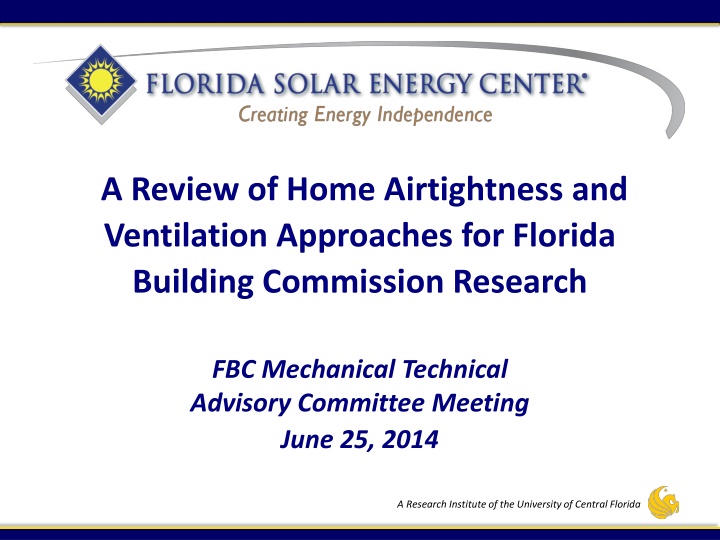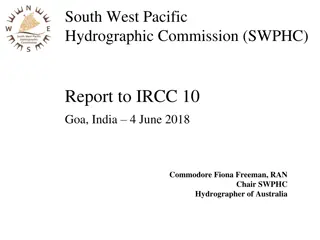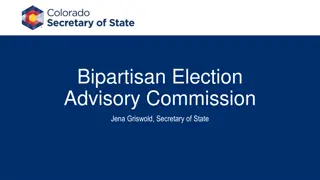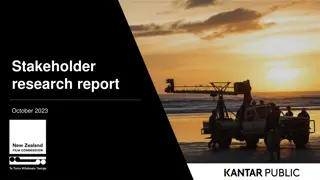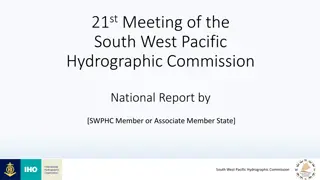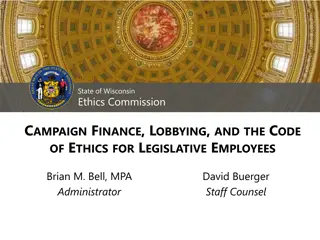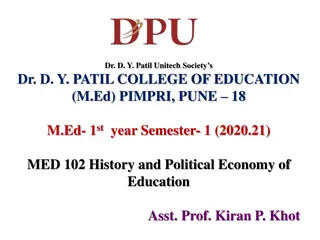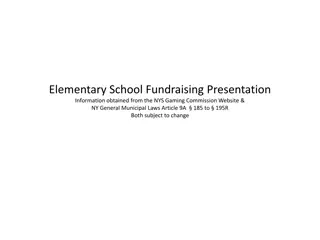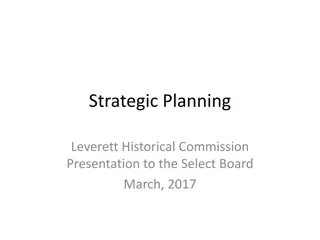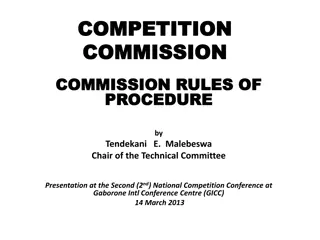Building Commission Research
Conduct a literature review, examine experimental data, and calculate energy impacts of ventilation systems in Florida buildings to develop alternative approaches for achieving acceptable ventilation levels. Consider factors such as energy use, indoor humidity, combustion safety, and ventilation system performance.
Download Presentation

Please find below an Image/Link to download the presentation.
The content on the website is provided AS IS for your information and personal use only. It may not be sold, licensed, or shared on other websites without obtaining consent from the author.If you encounter any issues during the download, it is possible that the publisher has removed the file from their server.
You are allowed to download the files provided on this website for personal or commercial use, subject to the condition that they are used lawfully. All files are the property of their respective owners.
The content on the website is provided AS IS for your information and personal use only. It may not be sold, licensed, or shared on other websites without obtaining consent from the author.
E N D
Presentation Transcript
A Review of Home Airtightness and Ventilation Approaches for Florida Building Commission Research FBC Mechanical Technical Advisory Committee Meeting June 25, 2014 A Research Institute of the University of Central Florida
Tasks Task 1: Conduct a literature review, examination of experimental data, and calculations of energy impacts of using or not using various types of ventilation systems. Task 2: Develop alternative approaches to achieving acceptable levels of ventilation while avoiding the risks associated with super-tight home enclosures and potential mechanical system failures. 2 FLORIDA SOLAR ENERGY CENTER A Research Institute of the University of Central Florida
Literature Review Over 40 articles, research reports, presentations and code documents were reviewed. Information sources included: American Council for an Energy-Efficient Economy (ACEEE) American Society of Heating, Refrigerating and Air-Conditioning Engineers (ASHRAE) Building Science Corporation (BSC) Florida Solar Energy Center (FSEC) International Code Council (ICC) Lawrence Berkeley National Laboratory (LBNL) US Environmental Protection Agency (EPA) 3 FLORIDA SOLAR ENERGY CENTER A Research Institute of the University of Central Florida
Literature Review Wide consensus that both controlling infiltration and providing mechanical ventilation is necessary for homes, but determining appropriate levels for each is much more involved. Considerations must include: Energy use Indoor humidity impacts Combustion safety Ventilation system performance Maintenance 4 FLORIDA SOLAR ENERGY CENTER A Research Institute of the University of Central Florida
Cooling Season Infiltration Loose House Higher moisture load from outside than tight house Heat (sensible) load over entire cooling season similar to tight due to small indoor / outdoor temperature diff. Tight House Small relative humidity improvement in the house Very small energy savings AC runs and removes moisture High dew point outside A/C 5 FLORIDA SOLAR ENERGY CENTER A Research Institute of the University of Central Florida
Heating Season Infiltration Loose House More dry air from outside than tight house When heating, wind speeds and temperature difference larger than when cooling so there is more heating load created than for tight house. Tight House Higher relative humidity due to interior moisture generation-- possible condensation if single pane glass or metal frames About 15% heating savings Heater runs, moisture not removed Low dew point outside A/C 6 FLORIDA SOLAR ENERGY CENTER A Research Institute of the University of Central Florida
Air Tightening Air tightening allows control over where and how much outside air enters a house Measured 2009 Florida Code home average ACH50 = 5.6 (31 home sample) 2014 Code requirement is <= 5 ACH50 Air tightening shown to provide limited summer energy savings and more significant percentage savings in winter Mechanical ventilation energy use may exceed air tightening savings 7 FLORIDA SOLAR ENERGY CENTER A Research Institute of the University of Central Florida
Arguments for Build it Tight Control infiltration sources and rates Reduce peak winter drafts and loads Can use continuous mechanical ventilation to deliver required air year round 8 FLORIDA SOLAR ENERGY CENTER A Research Institute of the University of Central Florida
Arguments Against Extremely Tight Unbalanced airflow (such as exhaust fans, unbalanced return air or duct leakage) can depressurize the interior space leading to combustion appliance spillage, back-drafting and flame roll-out Lack of fresh air when mechanical ventilation system fails Can create winter moisture issues In Florida, small savings from tight to extremely tight 9 FLORIDA SOLAR ENERGY CENTER A Research Institute of the University of Central Florida
How Much Outside Air? Health related research almost non existent Agreement that there are indoor pollutants Quantity of outside air required has been more of a consensus than a science 2012 IMC / 2014 FMC: continuous ventilation at 0.35 ach but not less than 15 cfm/person 2012 IRC / 2014 FRC: continuous ventilation rate provided by Table M1507.3.3(1) 10 FLORIDA SOLAR ENERGY CENTER A Research Institute of the University of Central Florida
How Much Outside Air? Movement toward health-based whole house ventilation; LBNL researching and working to incorporate a health metric into the 2016 version of ASHRAE 62.2 11 FLORIDA SOLAR ENERGY CENTER A Research Institute of the University of Central Florida
Ventilation Performance and Failure Limited whole house ventilation performance and failure research results available Significant number of systems not complying with Code requirements Component failure Installation issues Homeowner understanding and maintenance 12 FLORIDA SOLAR ENERGY CENTER A Research Institute of the University of Central Florida
Recommendations Reasonably tight with neutral or slightly positive mechanical ventilation 13 FLORIDA SOLAR ENERGY CENTER A Research Institute of the University of Central Florida
Specific recommendations include: Do not require further air tightening beyond the 2012 IECC level of 5 ACH50 Savings too small Potentially significant health and safety risks from mechanical ventilation failure or unbalanced airflow if house gets too tight Focus on sealing pathways between indoors and attic, garage and crawlspace Move toward health-based ventilation standards- will require collaborative research Educate public about pollutant sources and controlling them in homes (Green home programs attempt this) 14 FLORIDA SOLAR ENERGY CENTER A Research Institute of the University of Central Florida
Specific recommendations include: Ventilation system design Flexible airflow rate: provides flexibility if/as recommendations change and allows seasonal adjustments High efficiency fans: allows oversized fans to run at low speeds (for runtime vent); also may soon be possible to specify 0.2 or 0.3 Watts/cfm instead of 2014 FEC specification of ~0.35 Watts/cfm 15 FLORIDA SOLAR ENERGY CENTER A Research Institute of the University of Central Florida
Specific recommendations include: Ventilation system design (cont.) Positive pressure or balanced: provides air source control and reduces risk of exhaust dominated systems driving moist air through envelopes leading to mold and mildew at low permeability locations Moisture removal: have means to remove moisture introduced by the ventilation air (DBPR Indoor RH research) 16 FLORIDA SOLAR ENERGY CENTER A Research Institute of the University of Central Florida
Specific recommendations include: Ventilation system design (cont.) Proper intake locations: 2014 FEC requirement not allowing ventilation air to come from attics, crawlspaces, attached garages or outdoor areas close to pools or spas should be added to IECC Also do not allow sources near insecticide spray locations, car exhaust, AC condensers or dryer exhausts 17 FLORIDA SOLAR ENERGY CENTER A Research Institute of the University of Central Florida
Specific recommendations include: Balanced ventilation systems as one option Supply and exhaust ducts Allows balanced or positive house pressure Requires first cost and energy use of two fans Enthalpy (energy) recovery ventilation (ERV) option reduces heat and moisture gains from ventilation air, although not effective at times in swing seasons; also maintenance issues 18 FLORIDA SOLAR ENERGY CENTER A Research Institute of the University of Central Florida
Specific recommendations include: Supply only ventilation systems as another option Energy use and first cost of one fan Can be combined with dedicated outdoor air systems (DOAS), standard air conditioners and/or dehumidifiers to remove moisture Runtime option + appropriate controls can be effective during peak cooling and heating seasons; can raise humidity during swing seasons 19 FLORIDA SOLAR ENERGY CENTER A Research Institute of the University of Central Florida
Specific recommendations include: Consider mandating some type of alarm system for when a whole-house ventilation system failure is detected (limited field studies raise concerns about longevity, homeowner operation and maintenance of these systems) Initiate Florida whole-house ventilation system effectiveness and failure study. 20 FLORIDA SOLAR ENERGY CENTER A Research Institute of the University of Central Florida
